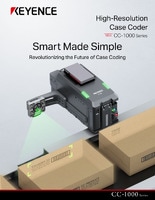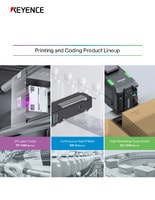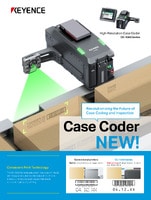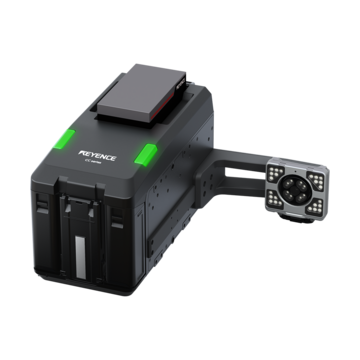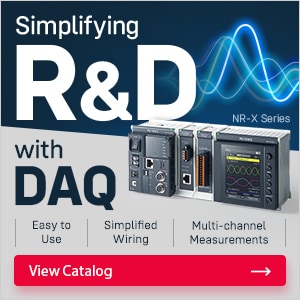Continuous Inkjet Printers / Case Coder
Materials and Products
Production Machines
Printing Applications
How GS1 Sunrise 2027 Will Affect Case Coding
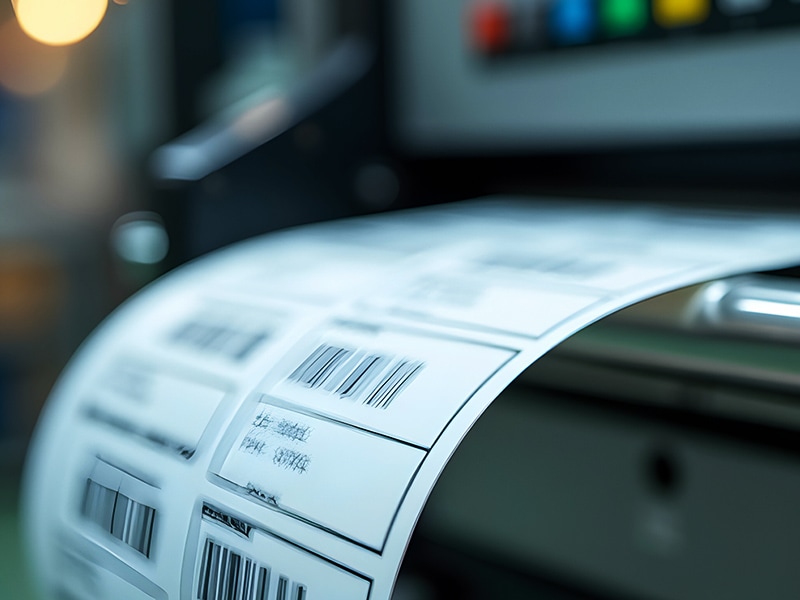
The GS1 Sunrise 2027 introduces a new global standard for product identification, prioritizing traceability, real-time data access, and consumer transparency. While the initiative focuses on scanners at checkout, its effects begin much earlier at the case coder.
Case coding systems must now support more complex data, tighter print tolerances, and faster adaptation to product-level variables. For companies aiming to stay competitive and compliant, the case coder evolves from a simple marking tool to a strategic asset.
Why 2D Barcodes on Cases Are Mandatory
GS1 Sunrise 2027 sets a clear expectation: By the end of 2027, point-of-sale systems worldwide must be capable of scanning both traditional 1D barcodes and newer 2D formats, such as QR and DataMatrix codes. This change is already underway in nearly 50 countries, covering over 88% of global GDP.
Unlike legacy UPCs, 2D barcodes can hold thousands of characters. This enables batch numbers, expiration dates, origin details, and recall data to be included in a single scannable mark. For retailers and regulators, that level of embedded data enables faster recalls, stronger authentication, and end-to-end product visibility. For consumers, this means access to nutrition facts, allergen information, and sourcing details directly on the package.
We’re here to provide you with more details.
Reach out today!

Technical Requirements for Case Coders
Meeting 2D barcode compliance isn’t as simple as updating software or swapping a printhead. These codes require precision at every stage, resolution, alignment, speed, and data management. A barcode that prints clearly but fails to scan consistently introduces risk.
Coders must now support higher DPI output to accurately reproduce fine lines, dense patterns, and large data payloads. Equipment must handle variable content generation at speed, printing lot codes and timestamps without pausing production. It’s not enough to print well; the system must remain consistent across varying line conditions, product sizes, and real-time data updates.
High-Resolution Print Standards
Many older case coders operate at a resolution of 200 DPI or lower, which may be sufficient for large-font alphanumerics but falls short when printing QR or DataMatrix codes. Lower resolution can lead to blurred lines, irregular droplet patterns, or partially formed symbols that scanners can’t interpret.
The KEYENCE CC-1000 Series meets this challenge with 360 DPI output and a staggered nozzle array, which maintains image integrity even if a nozzle becomes blocked. It also features a throw distance of up to 15 mm 0.6 inches, which helps mitigate splashback and misalignment, two common causes of downtime and degradation in print quality.
Unlike legacy printers that rely on close-proximity printing and fixed alignment, the CC-1000 Series’ multi-sensor unit detects changes in conveyor speed, vibration, and target distance, then adjusts the output accordingly.
Curious about our pricing?
Click here to find out more.

Real-Time Variable Data Printing
GS1 Sunrise 2027 is about relevant data. That means printing variable information like expiration dates, batch numbers, serialization, and other identifiers that change from product to product.
The MK-G Series excels in environments that require dynamic data. It supports up to six lines of print with automatic counters, date offsets, character assignment, and barcode and 2D code generation.
What sets the MK-G Series apart is its combination of speed and smart operation. When paired with accessories like the Operation Assist Camera, it can visually confirm printed output in real-time, capturing errors as they occur and enabling rapid correction. This is the type of closed-loop control that regulators increasingly expect and that traditional continuous inkjet (CIJ) systems can’t consistently deliver.
Printing vs Labeling on Corrugate
Labels have long been the fallback for difficult substrates, especially kraft corrugate, glossy cartons, or cases that require precise barcode placement. They offer high contrast and predictable print results. However, labels also introduce consumable costs, applicator maintenance, and potential for missed applications or misfeeds.
Direct printing, when done right, simplifies the process. Modern inkjet systems, such as the CC-1000 Series, now achieve barcode grades previously reserved for labels. With 360 DPI output, innovative nozzle management, and a vibration-compensated sensor array, the system can print cleanly even when box positioning varies.
Discover more about this product.
Click here to book your demo.

Impact on Existing Coding Systems
Legacy case coders were not designed with GS1 Sunrise 2027 in mind. Many don’t support the resolution or barcode formats required. Others lack the connectivity to communicate with ERP systems or validate printed output. And even those that can be upgraded often require workarounds to handle variable data or synchronize with new inspection tools.
Upgrading to a fully integrated solution provides long-term value beyond GS1 Sunrise 2027. The CC-1000 Series’ design features one-touch head core replacement, damage-free nozzle cleaning, and simplified maintenance videos, all of which reduce downtime and support lean operations. The MK-G Series, similarly, allows for automated startup, smart recovery, and print confirmation, all without disrupting flow.
Ultimately, manufacturers must weigh the short-term cost of upgrading against the long-term cost of missed compliance, slow recovery, and constrained adaptability. In most cases, the numbers speak for themselves.
Upgrade Your Case Coder
Stay ahead of GS1 Sunrise 2027 with equipment from KEYENCE, like the CC-1000 Series and MK-G Series. Built for real-time traceability and high-resolution barcode printing, they are ready for the next generation of coding.
Contact us to learn more about how our advanced technology can help take your business to the next level.
Contact Us
FAQs
What’s the Legal Deadline for GS1 Sunrise 2027 Compliance?
By the end of 2027, retailers will be required to accept 2D barcodes at the point of sale. Manufacturers are expected to begin transitioning now.
Can Existing CIJ Printers Be Upgraded for 2D Barcode Printing?
Some can, but limitations in DPI, software compatibility, or data handling often make full replacement more practical.
Do Corrugate Box Materials Affect Barcode Readability?
Yes. Low-contrast materials, such as kraft paper, can lower barcode readability. High-DPI printing and longer throw distance help maintain readability.
How Can I Ensure My Company Stays Compliant with GS1 Sunrise 2027?
Start by evaluating your current printing systems. Look for case coders that support 2D codes, variable data, real-time inspection, and integration with upstream systems.
We’re here to provide you with more details.
Reach out today!

Related Downloads
Related Products
Applications
Materials and Products
- Glass Bottles
- Plastic Bottles/Containers
- Cans
- Wires, Cables, & Pipes
- Pouches
- Metal Parts
- Corrugate Boxes
- Packaging Film
- Kraft Packaging
- Folding Cartons
- Building Materials
- PCBs
- Cartons
- Pallets & Lumber
- Corrugate Trays
Production Machines
- Paper Bag Packaging
- Box Conveyor
- Automatic Palletizer
- Sealer/Taping Machine
- Bottle Filling Machine
- Flow Wrapper

